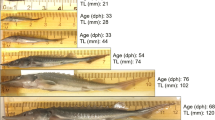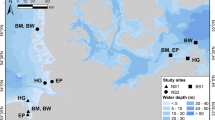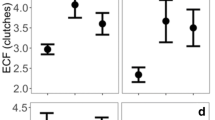Abstract
Transgenerational isotope labelling (TRAIL) using enriched stable isotopes provides a novel means of mass-marking marine fish larvae and estimating larval dispersal. The technique, therefore, provides a new way of addressing questions about demographic population connectivity and larval export from no-take marine protected areas. However, successful field applications must be preceded by larval rearing studies that validate the geochemical marking technique, determine appropriate concentrations and demonstrate that larvae are not adversely affected. Here, we test whether injection of enriched stable barium isotopes (135Ba and 137Ba) at two dose rates produces unequivocal marks on the otoliths of the coral reef grouper Epinephelus fuscoguttatus. We also assess potential negative effects on reproductive performance, egg size, condition and larval growth due to injection of adult female fish. The injection of barium isotopes at both 0.5 and 2.0 mg Ba/kg body weight into the body cavities of gravid female fish was 100% successful in the geochemical tagging of the otoliths of larvae from the first spawning after injection. The low-dose rate produced no negative effects on eggs or larvae. However, the higher dose rate of 2 mg Ba/kg produced small reductions in yolk sac area, oil globule area, standard length and head depth of pre-feeding larvae. Given the success of the 0.5 mg Ba/kg dose rate, it is clearly possible to produce a reliable mark and keep the concentration below any level that could affect larval growth or survival. Hence, enriched Ba isotope injections will provide an effective means of mass-marking grouper larvae.




Similar content being viewed by others
References
Abesamis RA, Russ GR, Alcala AC (2006) Gradients of abundance of fish across no-take marine reserve boundaries: evidence from Philippine coral reefs. Aquatic Cons: Mar Freshw Ecosyst 16:349–371
Agardy MT (1994) Advances in marine conservation: the role of marine protected areas. Trends Ecol Evol 9:267–270
Almany GR, Berumen ML, Thorrold SR, Planes S, Jones GP (2007) Local replenishment of coral reef fish populations in a marine reserve. Science 316:742–744
Baillie JEM, Hilton-Taylor C, Stuart SN (eds) (2004) 2004 IUCN red list of threatened species. A global species assessment. IUCN, Gland, Switzerland and Cambridge, UK, 191 pp
Botsford LW, White JW, Coffroth MA, Paris CB, Planes S, Shearer TL, Thorrold SR, Jones GP (2009) Connectivity and resilience of coral reef metapopulations in MPAs: matching empirical efforts to predictive needs. Coral Reefs 28:327–337
Cheung WWL, Pitcher TJ, Pauly D (2005) A fuzzy logic expert system to estimate intrinsic extinction vulnerabilities of marine fishes to fishing. Biol Cons 124:97–111
Cowen RK, Lwiza KMM, Sponaugle S, Paris CB, Olson DB (2000) Connectivity of marine populations: open or closed? Science 287:857–859
Cowen RK, Paris CB, Srinivasan A (2006) Scaling of connectivity in marine populations. Science 311:522–527
Dayton PK, Sala E, Tegner MJ, Thrush S (2000) Marine reserves: parks, baselines, and fishery enhancement. Bull Mar Sci 66:617–634
FitzGerald JL, Thorrold SR, Bailey KM, Brown A, Severin KP (2004) Elemental signatures in otoliths of larval walleye pollock (Theragra calcogramma) from the northeast Pacific Ocean. Fish Bull US 102:604–616
Gagliano M, McCormick MI (2007) Maternal condition influences phenotypic selection on offspring. J Anim Ecol 76:174–182
Gell FR, Roberts CM (2003) Benefits beyond boundaries: the fishery effects of marine reserves. Trends Ecol Evol 18:448–455
Gerlach G, Atema J, Kingsford MJ, Black KP, Miller-Sims V (2007) Smelling home can prevent dispersal of reef fish larvae. Proc Nat Acad Sci USA 104:858–863
Green BS, McCormick MI (2005) Maternal and paternal effects determine size, growth and performance in larvae of a tropical reef fish. Mar Ecol Progr Ser 289:263–272
Halpern BS (2003) The impact of marine reserves: do reserves work and does reserve size matter? Ecol Appl 13:S117–S137
Halpern BS, Warner RR (2002) Marine reserves have rapid and lasting effects. Ecol Lett 5:361–366
IUCN (2009) IUCN Red List of Threatened Species. Version 2009.1. https://doi.org/www.iucnredlist.org
James MK, Armsworth PR, Mason LB, Bode L (2002) The structure of reef fish metapopulations: modelling larval dispersal and retention patterns. Proc Roy Soc Lond Ser B 269:2079–2086
Jones GP, Milicich MJ, Emslie MJ, Lunow C (1999) Self-recruitment in a coral reef fish population. Nature 402:802–804
Jones GP, Planes S, Thorrold SR (2005) Coral reef fish larvae settle close to home. Curr Biol 15:1314–1318
Jones GP, Srinivasan M, Almany GR (2007) Population connectivity and conservation of marine biodiversity. Oceanography 20:100–111
Liao IC, Su HM, Chang EY (2001) Techniques in finfish larviculture in Taiwan. Aquaculture 200:1–31
Marte CL (2003) Larviculture of marine species in Southeast Asia: current research and industry prospects. Aquaculture 227:293–304
McClanahan TR, Mangi S (2000) Spillover of exploitable fishes from a marine park and its effect on the adjacent fishery. Ecol Appl 10:1792–1805
Mora C, Sale PF (2002) Are populations of coral reef fish open or closed? Trends Ecol Evol 17:422–428
Mora C, Andréfouët S, Costello MJ, Kranenburg C, Rollo A, Veron J, Gaston KJ, Myers RA (2006) Coral reefs and the global network of marine protected areas. Science 312:1750–1751
Palumbi SR (2004) Marine reserves and ocean neighbourhoods: the spatial scale of marine populations and their management. Ann Rev Env Res 29:31–68
Pears RJ, Choat JH, Mapstone BD, Begg GA (2006) Demography of a large grouper, Epinephelus fuscoguttatus, from Australia’s Great Barrier Reef: implications for fishery management. Mar Ecol Progr Ser 307:259–272
Pet JS, Mous PJ, Muljadi AH, Sadovy YJ, Squire L (2005) Aggregations of Plectropomus areolatus and Epinephelus fuscoguttatus (groupers, Serranidae) in the Komodo national park, Indonesia: monitoring and implications for management. Env Biol Fish 74:209–218
Purcell JFH, Cowen RK, Hughes CR, Williams DA (2006) Weak genetic structure indicates strong dispersal limits: a tale of two coral reef fish. Proc Roy Soc Ser B 273:1483–1490
Rimmer M (2000) Review of grouper hatchery technology. SPC Live Reef Fish Information Bulletin 7. https://doi.org/www.coraltrianglecenter.org/downloads/Rimmer%202000.pdf
Roberts CM, Hawkins JP (1999) Extinction risk in the sea. Trends Ecol Evol 14:241–246
Roberts CM, Hawkins JP, Gell FR (2005) The role of marine reserves in achieving sustainable fisheries. Philo Trans Roy Soc B 360:123–132
Russ GR (2002) Yet another review of marine reserves as reef fisheries management tools. In: Sale PF (ed) Coral reef fishes: dynamics and diversity in a complex ecosystem. Academic Press, San Diego, pp 421–443
Sadovy Y (2000) Regional survey for fry/fingerling supply and current practices for grouper mariculture: evaluating current status and long-term prospects for grouper mariculture in South East Asia. Final report to the Collaborative APEC grouper research and development network (FWG 01/99). December, 2000
Sadovy YJ, Vincent ACJ (2002) Ecological issues and the trades in live reef fishes. In: Sale PF (ed) Coral reef fishes: dynamics and diversity in a complex ecosystem. Academic Press, San Diego, pp 391–420
Sale PF, Cowen RK, Danilowicz BS, Jones GP, Kritzer JP, Lindeman KC, Planes S, Polunin NVC, Russ GR, Sadovy YJ, Steneck RS (2005) Critical science gaps impede use of no-take fishery reserves. Trends Ecol Evol 20:74–80
Sturgeon RE, Willie SN, Yang L, Greenberg R, Spatz RO, Chen Z, Scriver C, Clancy V, Lam JW, Thorrold SR (2005) Certification of a fish otolith reference material in support of quality assurance for trace element analysis. J Anal Atom Spectrom 20:1067–1071
Swearer SE, Caselle JE, Lea DW, Warner RR (1999) Larval retention and recruitment in an island population of coral-reef fish. Nature 402:799–800
Thorrold SR, Jones GP, Hellberg ME, Burton RS, Swearer SE, Neigel JE, Morgan SG, Warner RR (2002) Quantifying larval retention and connectivity in marine populations with artificial and natural markers. Bull Mar Sci 70:S291–S308
Thorrold SR, Jones GP, Planes S, Hare JA (2006) Transgenerational marking of embryonic otoliths in marine fishes using barium stable isotopes. Can J Fish Aquat Sci 63:1193–1197
Thorrold SR, Zacherl DC, Levin LA (2007) Population connectivity and larval dispersal—using geochemical signatures in calcified structures. Oceanography 20:80–89
Williamson DH, Russ GR, Ayling AM (2004) No-take marine reserves increase abundance and biomass of reef fish on inshore fringing reefs of the Great Barrier Reef. Env Cons 31(2):149–159
Williamson DH, Jones GP, Thorrold SR, Frisch AJ (2009) Transgenerational marking of marine fish larvae: stable isotope retention, physiological effects and health issues. J Fish Biol 74:891–905
Yap WG, FungeSmith S, Rimmer M, Phillips MJ, Sim SY, Kongkeo H, Bueno PB (2006) Aquaculture in Asia-Pacific and the outlook for mariculture in Southeast Asia. https://doi.org/library.enaca.org/NACA-Publications/Overview_of_Aquaculture.pdf
Zacherl DC (2005) Spatial and temporal variation in statolith and protoconch trace elements as natural tags to track larval dispersal. Mar Ecol Progr Ser 290:145–163
Acknowledgments
This work was made possible through the assistance of the Gondol Research Institute for Mariculture, Bali Indonesia. Special thanks to Dr. Adi Hinafi (Director), Dr. Agus Priyono, Dr. Nyoman Adiasmara Giri, Dr. K. Suwirya, I. Made Sedana, Mohammed Sapri, Agus Supriatna, Katimin. Thanks also to Dr. Mike Rimmer, Adam Reynolds and Anjanette Johnston from the Northern Fisheries Centre (QDPI & F), Cairns, QLD. The primary funding for this work was provided by the Australian Marine and Tropical Sciences Research Facility (MTSRF), with additional support from the ARC Centre of Excellence for Coral Reef Studies, and the US National Science Foundation (OCE-0424688).
Author information
Authors and Affiliations
Corresponding author
Additional information
Communicated by U. Sommer.
Rights and permissions
About this article
Cite this article
Williamson, D.H., Jones, G.P. & Thorrold, S.R. An experimental evaluation of transgenerational isotope labelling in a coral reef grouper. Mar Biol 156, 2517–2525 (2009). https://doi.org/10.1007/s00227-009-1276-0
Received:
Accepted:
Published:
Issue Date:
DOI: https://doi.org/10.1007/s00227-009-1276-0




